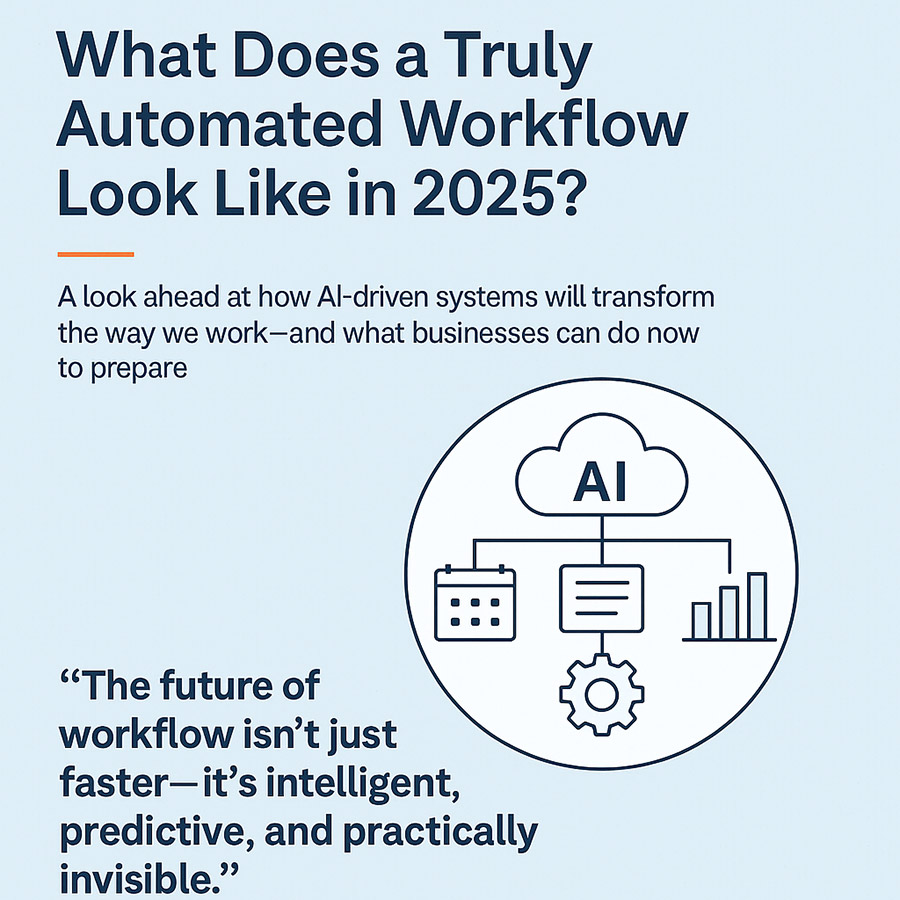A look ahead at how AI-driven systems will transform the way we work—and what businesses can do now to prepare.
Automation is no longer about just speeding things up—it’s about transforming how we think, decide, and work. As we approach the half of 2025, AI-powered workflows are becoming less about task completion and more about intelligent orchestration. But what does that actually look like in a real-world business?
In short: Workflows that think for themselves.
“The future of workflow isn’t just faster—it’s intelligent, predictive, and practically invisible.”
From Reactive to Predictive: The Shift in Workflow Intelligence
Today’s automated systems already help businesses route forms, trigger alerts, or assign tasks. But in the second half of 2025, the most advanced workflows will anticipate needs before you even ask.
Picture this:
- A marketing tool that recommends the next campaign based on last month’s engagement trends
- A customer service bot that escalates a case before dissatisfaction turns into churn
- A financial system that flags inconsistencies based on historical data and real-time shifts in cash flow
This leap from rules-based automation to learning-based orchestration is what’s changing the game.
“By 2026, Gartner predicts that 70% of organizations will implement AI-powered automation in at least one business process.” — Gartner
Key Features of 2025 Workflows
-
Hyper-Personalization:
Systems will adapt to individual users. Your dashboard, tasks, and priorities will adjust based on how you work best. -
Predictive Triggers:
Rather than reacting to events, workflows will detect risk and opportunity ahead of time—giving you a chance to respond proactively. -
Natural Language Interfaces:
No more digging through menus or sending IT tickets. You’ll tell the system what you need—just like texting a coworker. -
Spatial and Environmental Awareness:
With integration into physical spaces (via Spatial AI), workflows can even respond to location-based changes—like real-time factory conditions or in-store foot traffic.

How Businesses Can Prepare Today
You don’t need to wait for the future to start benefiting. Here’s how to begin:
- Map out repetitive and rule-based tasks across departments.
- Invest in flexible platforms like Leaniar that allow you to build and adjust workflows over time.
- Train teams on change readiness by introducing one smart automation at a time.
- Measure ROI early to justify scaling system-wide.
Conclusion
The workplace of the second half of 2025 won’t run on busywork—it’ll run on foresight, personalization, and adaptive automation. With AI leading the charge, companies that embrace smart workflows now will be light-years ahead of those that don’t.
FAQs:
Will AI automation replace jobs in 2025?
No—it will replace repetitive tasks, allowing employees to focus on creative, strategic work that adds more value.
Can AI predict workflow failures?
Yes. Predictive analytics is one of the most powerful aspects of modern AI systems—it identifies patterns before issues arise.
Is this tech only available to large enterprises?
No—tools like Leaniar are built to be scalable and accessible for startups, SMBs, and large corporations alike.
How do I know if I’m ready for AI workflow automation?
If your team repeats the same task more than 10 times a week, you’re ready.






